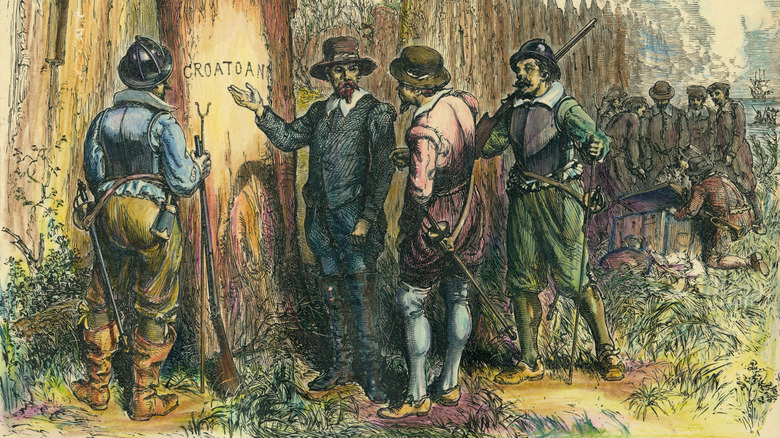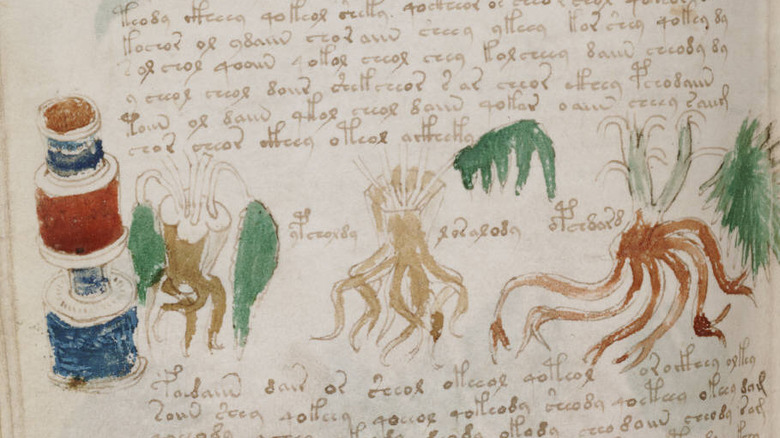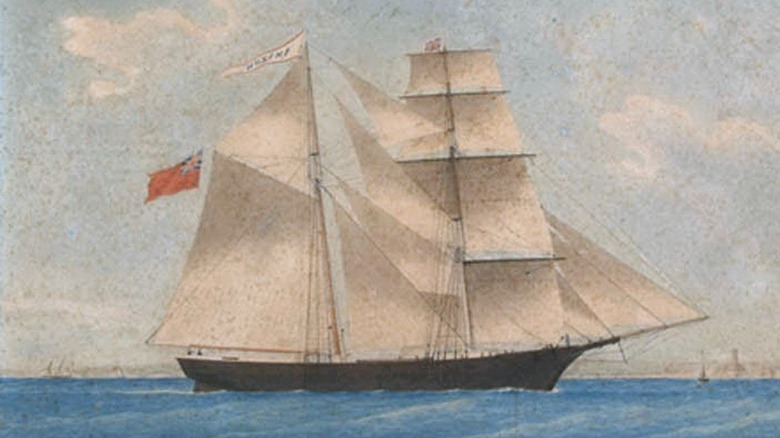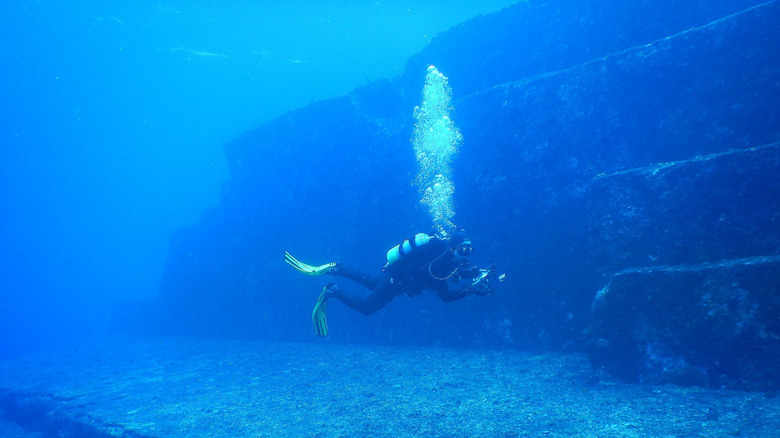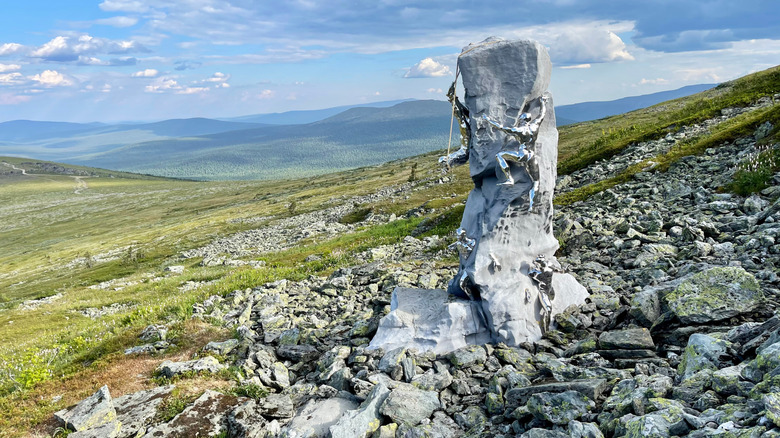Theories About Famous Mysteries That Actually Make Sense
We all love a good mystery. In fact, some of us may enjoy unsolved stories so much that digging into the likely truth can feel like a bit of a letdown. But following that thread can not only lead us to answers to age-old questions, but also new and even more fascinating insights into science and history.
For instance, while the strikingly-named Wow! signal might not really be evidence of first contact between humans and an extraterrestrial species, it could point the way to an ultra-cool astronomical phenomenon blasting radio waves through deep space to our lonely planet. And, sure, the mystery of the so-called Lost Colony of Roanoke may actually have been carved right into a tree trunk for all to see. Yet, at the same time, archaeological evidence may uncover new ways in which European settlers and indigenous people managed to live and work together.
So, there's no need to turn away from possible answers. While these theories aren't exactly proven answers to old mysteries, they're solutions that will likely have you nodding your head, then leaning in closer to learn more.
The Wow! signal may be rooted in a unique astronomical phenomenon
If you ask most astronomers, chances are that they're all pretty skeptical when it comes to the question of extraterrestrials. But then there's the so-called Wow! signal. It was received the night of August 15, 1977, when Ohio State University's Big Ear radio observatory was hit by an oddly intense burst of radio energy. The 72-second signal sure seemed artificial, to the point where a SETI researcher scribbled the namesake "Wow!" on a printout.
But is this evidence of alien contact? Not so fast, say many scientists, who have proposed any number of explanations for the signal over the years. These include radio signals generated by plain old humans and energy emitted by known astronomical phenomena like comets. But getting a definite answer has proven tricky, as the signal never repeated (perhaps lending credence to the skeptics — after all, why wouldn't the aliens try calling again?).
Yet, researchers have found similar but much less intense emissions traveling to us from deep space hydrogen clouds. The pre-print paper describing this admittedly hasn't been accepted by a peer-reviewed journal as of writing, but it's worth consideration given that it comes from Cornell University's highly-regarded astronomy department. The paper's authors suggest that the sudden blast of radio back in 1977 may have been caused by a massive object like an intensely magnetic neutron star (called a magnetar) slamming into a hydrogen cloud and sending out a burst of radio signals — right to us.
The legend of El Dorado is linked to real indigenous goldsmiths
The story of El Dorado sounds entirely too good to be true. Seriously, was there any truth to this legend of a mythical city of gold? While the conquistadors should have known better, there are gold artifacts that are hard to ignore. Perhaps a power- and money-hungry colonizer holding a golden figurine or wondering at some gold dust could have been more easily convinced that the legendary city of gold really was out there somewhere.
And they wouldn't have been totally wrong. Now, no one's uncovered any evidence of an El Dorado paved in gold, but there is plenty of documentation on the Muisca people of what's now Colombia. According to 17th-century chronicler Juan Rodriguez Freyle, when the Muisca chief died, his successor would go through a series of rituals that built up to a grand ceremony at Lake Guatavita. There, the new ruler would appear coated in gold dust and, accompanied by religious figures also bedecked in gold, would toss objects made from the shining metal into the waters.
The gold wasn't valued so much for its high cost as it was for its spiritual significance, representing in some part the sacred rituals, places, and deities that Muisca society held dear. But, while the Muisca became renowned for their intricate goldsmithing and surely drew the attention of conquistadors, they never built an entire city out of the material.
The Voynich manuscript is possibly a medical text
In the world of mysterious texts, the crazy story of the Voynich manuscript is surely the cream of the indecipherable crop. It first came to wide attention in the early 20th century, when book dealer Wilfred Voynich acquired the text from Jesuit monks. Between the covers are over 200 pages of text and images, but the words are in some unknown script that appears to have consistent symbols and structure. The illustrations show all manner of things, from identifiable plants to more fantastical ones, astrological charts, and the occasional group of folks lounging about in what look like hot springs. Carbon dating has confirmed that the book was made around the 15th century, and scholars who have studied the book have concluded that it isn't a modern or historic hoax.
Naturally, many theories have been floated about the author and purpose of the book (Voynich favored the idea that medieval monk and intellectual Roger Bacon was its author). One of the most persuasive may be that it's a medical text. Page through the book and you'll see plenty of plants — herbal remedies were a key part of the medieval doctor's kit — along with what could be medicine bottles. Given the many female figures in a state of undress seen throughout the text, some have even suggested that it's a text dedicated to women's health, which perhaps explains the tricky cipher for a sensitive subject.
We have a pretty good idea where the people of Mesa Verde went
If you visit the sometimes underrated Mesa Verde National Park in southwestern Colorado today, you'll get the chance to view the astonishing cliff dwellings once inhabited by indigenous people centuries ago. But why did they all leave town about 700 years ago, and where did they head? Unscrupulous writers or tour guides might make it seem as if they mysteriously vanished into the mists of time, but remain skeptical. While getting answers about a massive population shift that happened long ago and without any written record is tough, there is a pretty good theory.
These people – Ancestral Puebloan is often the preferred term — didn't just live at Mesa Verde but throughout the southwest, including sites at Chaco Canyon in New Mexico and Canyon de Chelly in Arizona. There is good archaeological evidence that many of these sites were abandoned by the 14th century A.D., with excavations suggesting many people moved south.
As to why, the best explanation appears to be that the Ancestral Puebloans were dealing with a complicated mix of climate change, overhunting, economic stress, and warfare that left behind human remains with violent wounds and occasional evidence of cannibalism. As far as anyone can tell, the indigenous people may have moved far south or stayed a bit closer to become the ancestors of modern indigenous folks, like those in the Tewa Basin region of what is now northern New Mexico.
There's a pretty reasonable explanation for the Mary Celeste ghost ship
Is the tale of the Mary Celeste ghost ship really as eerie as it's made out to be? The facts of the matter start in late 1872, when the ship set off from New York City to Italy. It was crewed by a relatively small team of eight sailors, along with Captain Benjamin S. Briggs, his wife, Sarah, and their toddler daughter Sophia. The ship also carried about 1,700 barrels of alcohol in its hold. Mere weeks later, it was found adrift between the Azores and mainland Europe. Besides waterlogged holds and a missing longboat, nothing appeared amiss — apart from the total absence of anyone on board.
Many theories for the disappearance have been bandied about, from opportunistic sailors killing everyone to claim the cargo to hungry sea monsters picking everyone off. Yet there's one part of the puzzle that may hold the key: the cargo hold. There was a very real fear that the cargo could catch fire and even become explosive, but there was no evidence that this really happened. Yet, given a seemingly damaged bilge pump and the packed hold, it's possible that Briggs thought the ship was taking on too much water and couldn't check for himself. Readings from backup methods, like the sounding rod that was found on deck, may have been misinterpreted.
Perhaps, fearing the worst, Briggs ordered everyone to the longboat. But something could have easily gone wrong, causing the smaller boat to helplessly drift away, leaving only the Mary Celeste behind as evidence that they were ever there in the first place.
The Flannan Isles lighthouse disappearances perhaps aren't so mysterious
Situated in lonely places and with only the crash of waves against rocks as company, you might imagine a spell in a lighthouse as the ultimate introvert's vacation or a unique way to descend into madness. And that's without any mysterious disappearances dogging the location, as is the case with the Flannan Isles Lighthouse on a remote island in the northwestern reaches of Scotland.
The vanishing happened in December 1900, when three lighthouse keepers were on duty on the biggest island of the group, Eilean Mòr. These were the principal lightkeeper James Ducate, assistant lightkeeper Thomas Marshall, and occasional keeper Donald McArthur subbing in. Crews on Eilean Mòr expected to switch out every fortnight, or two weeks.
When a relief keeper traveled to the lighthouse on December 26, he found that the island was deserted. That keeper, Joseph Moore, stayed on with two volunteer sailors, ensuring the all-important light was operating. While there, they found evidence pointing to an abrupt yet mysterious disappearance. Everything inside seemed shipshape, with log entries dating to December 15. One of the few things out of place was the fact that two sets of outdoor gear were missing. Outside, Moore wrote that they found railings, ropes, and stones out of place, as if they had been battered by a vicious storm. The most likely scenario: a massive storm came through and, with the lighthouse keepers rushing outside to secure gear, washed them all away.
The Yonaguni Monument is likely a cool geological formation
If you go diving off the coast of Japan's Yonaguni Island, you may come across an odd collection of rocks. Now known as the Yonaguni Monument, to some the formation sports such regular, straight lines that it must be lingering evidence of some great, monument-building civilization. They claim to have spotted massive steps that must have been part of an ancient pyramid, along with arches, hallways, and carvings that were perhaps left by human hands. Oh, and some artifacts clearly made by humans, including pottery and tools, have been found here. Could this be Japan's Atlantis, sunk under the ocean waves long ago by some unidentified catastrophe?
Before you get too drawn into yet another tale of a submerged ancient city (and there are quite a lot, it seems), you may wish to consult a geologist. While some, like marine geologist Masaaki Kimura, are proponents of the ancient city theory, others point out that sandstone — like the very kind in this area — tends to break along planes and produce straight edges. That, combined with ocean currents and earthquake activity in the region, could explain the unusual shapes. Moreover, all those human-produced objects could just mean people were in the region, and not necessarily undertaking a massive 10,000-year-old construction project. It all points to the Yonaguni Monument being not quite a monument, but a nevertheless fascinating rock assemblage that formed all on its own.
The Peking Man fossils might be beneath a parking lot
The tale of Peking Man started in 1929, when paleontologist and archaeologist Pei Wenzhong was excavating in an area already known for rich fossil deposits. He found the well-preserved skeletal remains of a human ancestor known as Homo erectus, along with stone tools and evidence of a campfire. The individual came to be known as Peking Man (Peking being an old-school name for Beijing).
But an expansionist Japan was invading China and had its eyes on scientific and cultural valuables like the Peking Man bones. Chinese scientists asked American allies to ferry the fossils out of the country. In late 1941, they were packed up and transferred to the U.S. Marine base in the coastal city of Qinhuangdao. From there, we know that Japanese forces tried to recover Peking Man, but had no luck. Meanwhile, the base in Qinhuangdao was overrun. At this point, the fossils disappear from the record.
A 2012 paper published in the South African Journal of Science might just hold the key. Researchers were contacted by the son of Richard M. Bowen, who had been stationed in 1947 Qinhuangdao while serving in the U.S. Marines. While fortifying the base against advancing Communist soldiers, the Marines began to dig trenches. Bowen claimed to have uncovered an old footlocker full of skulls and hurriedly re-buried it. Scientists are pretty interested in the account, but excavating will be tricky, as the old base is now beneath a parking lot.
We have good evidence for the fate of Roanoke
If you love a good mystery, then you've almost certainly come across theories concerning the mysterious fate of Roanoke's Lost Colony. In the 1580s, English expeditions found Roanoke Island (on the coast of what's now North Carolina) to be a promising place for a colony. Having made friends with at least some of the native Roanoac and Croatoan people, the English established a military outpost and began making a rather bad impression by demanding more and more resources, all while giving indigenous people nasty diseases like smallpox. Still, they justified a civilian colony on Roanoke Island, though the colonists faced food scarcity and attacks from local tribes.
Leader John White, whose family was part of the group, went back to England for help, but upon his November 1587 arrival, he was held up for over two years. When White returned, the colony was abandoned, but he found the word "Croatoan" carved nearby. White set off for nearby Croatoan Island, but a storm pushed him off course and he was forced back to England. He died in 1606, never knowing what had happened.
Modern excavations on Croatoan — now Hatteras Island — have found evidence of European-style blacksmithing with other 16th-century items, such as glass, swords, and bits of guns mixed with indigenous ceramics and arrowheads. Is this definitive proof of the colonists? Not precisely, but it is mighty interesting. It's easy to imagine that anxious, resource-stressed colonists simply moved in with indigenous allies. What happened to them after that still isn't clear, but it's possible some assimilated into local tribes.
Flight 19 may have gotten fatally disoriented
Flight 19 was supposed to be boring. On December 5, 1945, the squadron of five Avenger bombers left a Navy base in Fort Lauderdale on a training mission that took them east across the Atlantic to drop some dummy bombs, north over the Bahamas, and back home to Florida. The group of 14 aviators was fairly experienced, including its commander, Lieutenant Charles C. Taylor. Only, before the planned flyover of Grand Bahama Island, Taylor became disoriented. Another Navy pilot in the area, Lieutenant Robert F. Cox, overheard the group's confused communications and tried to lend assistance.
Taylor told Cox he was pretty sure the group was somewhere near the Florida Keys, far off course and over the Gulf of Mexico. This meant that the standard advice to just fly towards the setting sun wouldn't get them back to Florida. The last known radio transmission from the group, growing fainter and fainter as they flew out to sea, was Taylor seemingly preparing them to ditch into the water ... wherever that water was. Despite a massive search effort, no trace of the squadron was found. It soon became one of the most notorious disappearances in the Bermuda Triangle.
So, was it aliens? A mysterious time portal? Most likely, it was confusion. Taylor had just transferred to the Fort Lauderdale base and, though he was coming from Miami, may have been confused about the location of various island groups and mistook the Bahamas for the Florida Keys. Once the fuel ran out, the planes would have ditched and the pilots left to the unforgiving ocean.
The Dyatlov Pass incident is terrifying but explainable
Even if you're an avowed fan of hiking and backwoods camping, the Dyatlov Pass incident surely puts a chill on the proceedings. Okay, it's not as if we're all planning a trip to the remote Ural Mountains, as nine college students did in January 1959. These students were all relatively experienced hikers who intended to contact their sports club after three weeks. When the message never came, searchers set out and found the bodies of five students, some barely clothed despite frigid temperatures; a further four were found as snow melted. Some showed signs of hypothermia, while two had massive chest trauma and another a major skull fracture.
The search party also found the group's wrecked tent partially buried in snow. It had been cut open from the inside, but most of the students' gear remained undisturbed. It all spoke to a sudden event and a panicked exit. It wasn't long before people hinted at cover-ups, alien attacks, or even an encounter with a yeti-type creature known as the menk.
But a 2021 paper published in Communications Earth & Environment argues that the Dyatlov Pass hikers were hit by a slab avalanche, in which a large chunk of snow — maybe destabilized by the hikers — could have broken loose in intense winds and slammed into the tent. This could have caused major injuries and explained why the less-injured hikers fled the tent (bringing injured companions with them). Meanwhile, hypothermia symptoms can include a behavioural response known as paradoxical undressing, while scavenging animals and natural decomposition can explain the shocking state of some of the bodies.
